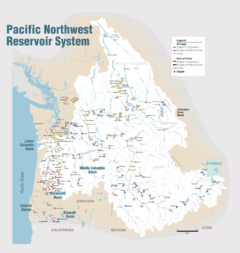| Dworshak Dam | |
|---|---|
 Aerial view from southwest, with spillways open | |
Location in Idaho | |
| Country | United States |
| Location | Clearwater County, Idaho |
| Coordinates | 46°30′54″N 116°17′46″W / 46.515°N 116.296°W |
| Purpose | Water storage, power |
| Construction began | 1966 |
| Opening date | 1973 |
| Construction cost | $327 million[1] ($2.24 billion in 2024[2]) |
| Owner(s) | U.S. Army Corps of Engineers |
| Dam and spillways | |
| Type of dam | Gravity dam |
| Impounds | North Fork of the Clearwater River |
| Height | 717 ft (219 m)[3] |
| Length | 3,287 ft (1,002 m)[3] |
| Spillways | Service, 2x tainter gates |
| Spillway capacity | 150,000 cu ft/s (4,200 m3/s)[3] |
| Reservoir | |
| Creates | Dworshak Reservoir |
| Total capacity | 3,468,000 acre⋅ft (4.278 km3)[3] |
| Active capacity | 2,016,000 acre⋅ft (2.487 km3)[3] |
| Catchment area | 2,440 sq mi (6,300 km2)[3] |
| Surface area | 17,090 acres (6,920 ha) (max)[3] |
| Normal elevation | 1,600 feet (490 m) AMSL |
| Power Station | |
| Commission date | 1973[4] |
| Hydraulic head | 560 ft (170 m)[3] |
| Turbines | 2x 90 MW 1x 220 MW[4] |
| Installed capacity | 400 MW[4] 460 MW[4] (max. planned) |
| Annual generation | 1.693 billion KWh[5] |
 | |
Dworshak Dam is a concrete gravity dam in the western United States, on the North Fork of the Clearwater River in north central Idaho. In Clearwater County, the dam is located approximately four miles (6 km) northwest of Orofino and impounds the Dworshak Reservoir for flood control and hydroelectricity generation. By capacity, the reservoir is the largest in Idaho and fourth-largest in the Pacific Northwest.
With a height of 717 feet (219 m), Dworshak is the third tallest dam in the U.S. and the tallest straight-axis concrete dam in the Western Hemisphere.[6] Construction of the dam by the U.S. Army Corps of Engineers (USACE) began in 1966 and was completed in 1973.
Lacking fish ladders, the dam blocks fish passage and completely extirpated anadromous fish migration into the upper reaches of the North Fork and its tributaries in Idaho.[7]
- ^ "Dworshak Reservoir Overview". U.S. Army Corps of Engineers. Archived from the original on September 27, 2011. Retrieved June 12, 2012.
- ^ 1634–1699: McCusker, J. J. (1997). How Much Is That in Real Money? A Historical Price Index for Use as a Deflator of Money Values in the Economy of the United States: Addenda et Corrigenda (PDF). American Antiquarian Society. 1700–1799: McCusker, J. J. (1992). How Much Is That in Real Money? A Historical Price Index for Use as a Deflator of Money Values in the Economy of the United States (PDF). American Antiquarian Society. 1800–present: Federal Reserve Bank of Minneapolis. "Consumer Price Index (estimate) 1800–". Retrieved February 29, 2024.
- ^ a b c d e f g h "Dworshak Dam and Reservoir Pertinent Data". U.S. Army Corps of Engineers. Archived from the original on February 16, 2012. Retrieved June 12, 2012.
- ^ a b c d "Dworshak Dam – General Information". Hydroelectric Information for Columbia and Snake River Projects. University of Washington School of Aquatic and Fishery Sciences. December 22, 2008. Retrieved June 12, 2012.
- ^ "Dworshak Dam and Reservoir". U.S. Army Corps of Engineers. June 17, 1997. Archived from the original on July 17, 2009. Retrieved June 12, 2012.
- ^ "Dworshak Dam". Building Big. Idaho Public Television. Archived from the original on April 21, 2012. Retrieved June 12, 2012.
- ^ "Dworshak Dam Complex" (PDF). Archived from the original (PDF) on April 2, 2021. Retrieved November 15, 2019.

